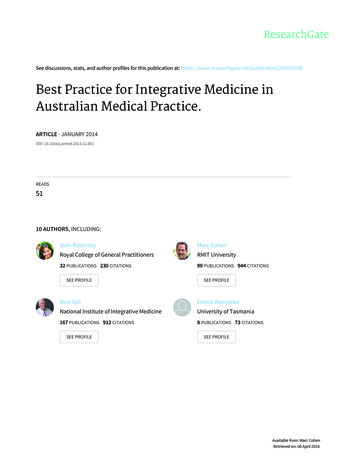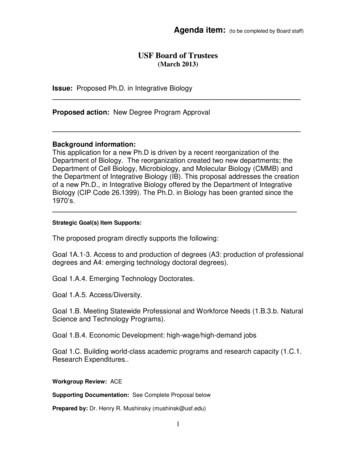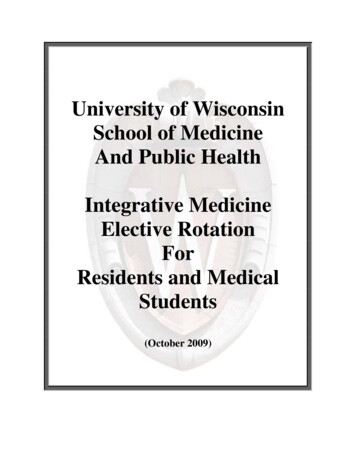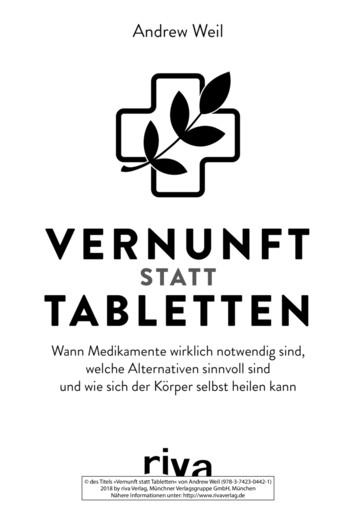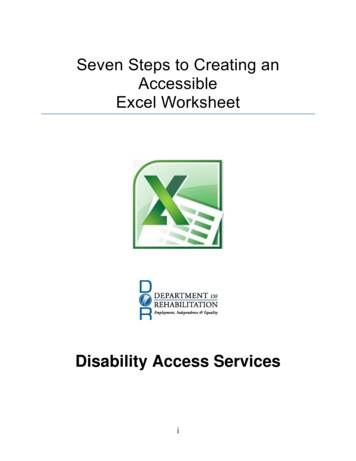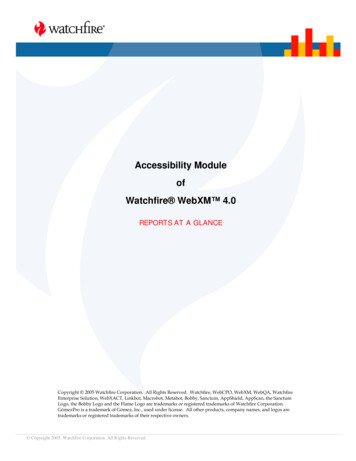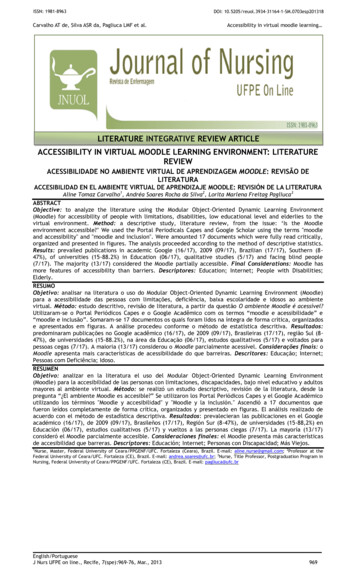
Transcription
ISSN: 1981-8963DOI: o AT de, Silva ASR da, Pagliuca LMF et al.Accessibility in virtual moodle learning LITERATURE INTEGRATIVE REVIEW ARTICLEACCESSIBILITY IN VIRTUAL MOODLE LEARNING ENVIRONMENT: LITERATUREREVIEWACESSIBILIDADE NO AMBIENTE VIRTUAL DE APRENDIZAGEM MOODLE: REVISÃO DELITERATURAACCESIBILIDAD EN EL AMBIENTE VIRTUAL DE APRENDIZAJE MOODLE: REVISIÓN DE LA LITERATURAAline Tomaz Carvalho1, Andréa Soares Rocha da Silva2, Lorita Marlena Freitag Pagliuca3ABSTRACTObjective: to analyze the literature using the Modular Object-Oriented Dynamic Learning Environment(Moodle) for accessibility of people with limitations, disabilities, low educational level and elderlies to thevirtual environment. Method: a descriptive study, literature review, from the issue: ‘Is the Moodleenvironment accessible?’ We used the Portal Periodicals Capes and Google Scholar using the terms "moodleand accessibility" and "moodle and inclusion". Were amounted 17 documents which were fully read critically,organized and presented in figures. The analysis proceeded according to the method of descriptive statistics.Results: prevailed publications in academic Google (16/17), 2009 (09/17), Brazilian (17/17), Southern (847%), of universities (15-88.2%) in Education (06/17), qualitative studies (5/17) and facing blind people(7/17). The majority (13/17) considered the Moodle partially accessible. Final Considerations: Moodle hasmore features of accessibility than barriers. Descriptores: Education; Internet; People with Disabilities;Elderly.RESUMOObjetivo: analisar na literatura o uso do Modular Object-Oriented Dynamic Learning Environment (Moodle)para a acessibilidade das pessoas com limitações, deficiência, baixa escolaridade e idosos ao ambientevirtual. Método: estudo descritivo, revisão de literatura, a partir da questão O ambiente Moodle é acessível?Utilizaram-se o Portal Periódicos Capes e o Google Acadêmico com os termos “moodle e acessibilidade” e“moodle e inclusão”. Somaram-se 17 documentos os quais foram lidos na íntegra de forma crítica, organizadose apresentados em figuras. A análise procedeu conforme o método de estatística descritiva. Resultados:predominaram publicações no Google acadêmico (16/17), de 2009 (09/17), Brasileiras (17/17), região Sul (847%), de universidades (15-88.2%), na área da Educação (06/17), estudos qualitativos (5/17) e voltados parapessoas cegas (7/17). A maioria (13/17) considerou o Moodle parcialmente acessível. Considerações finais: oMoodle apresenta mais características de acessibilidade do que barreiras. Descritores: Educação; Internet;Pessoas com Deficiência; Idoso.RESUMENObjetivo: analizar en la literatura el uso del Modular Object-Oriented Dynamic Learning Environment(Moodle) para la accesibilidad de las personas con limitaciones, discapacidades, bajo nivel educativo y adultosmayores al ambiente virtual. Método: se realizó un estudio descriptivo, revisión de la literatura, desde lapregunta “¿El ambiente Moodle es accesible?” Se utilizaron los Portal Periódicos Capes y el Google Académicoutilizando los términos "Moodle y accesibilidad" y "Moodle y la inclusión." Ascendió a 17 documentos quefueron leídos completamente de forma crítica, organizados y presentado en figuras. El análisis realizado deacuerdo con el método de estadística descriptiva. Resultados: prevalecieran las publicaciones en el Googleacadémico (16/17), de 2009 (09/17), Brasileños (17/17), Región Sur (8-47%), de universidades (15-88,2%) enEducación (06/17), estudios cualitativos (5/17) y vueltos a las personas ciegas (7/17). La mayoría (13/17)consideró el Moodle parcialmente accesible. Consideraciones finales: el Moodle presenta más característicasde accesibilidad que barreras. Descriptores: Educación; Internet; Personas con Discapacidad; Más Viejos.1Nurse, Master, Federal University of Ceara/PPGENF/UFC. Fortaleza (Ceara), Brazil. E-mail: aline.nurse@gmail.com; 2Professor at theFederal University of Ceara/UFC. Fortaleza (CE), Brazil. E-mail: andrea.soares@ufc.br; 3Nurse, Title Professor, Postgraduation Program inNursing, Federal University of Ceara/PPGENF/UFC. Fortaleza (CE), Brazil. E-mail: pagliuca@ufc.brEnglish/PortugueseJ Nurs UFPE on line., Recife, 7(spe):969-76, Mar., 2013969
ISSN: 1981-8963DOI: o AT de, Silva ASR da, Pagliuca LMF et al.INTRODUCTIONThe use of Information and CommunicationTechnologies (ICT) in education is increasinglywidespread throughout the world, especiallythrough the use of internet, computers andeven mobile devices like cell phones.However, some groups still encounter barriersin using these technologies or do not haveaccess to information such as the elderly,people with disabilities or little schooling.According to data from the NationalHousehold Sample (PANAD) in 2008, 56 millionpeople aged ten and older accessed theInternet, among which 11.2% were 50 years orolder and 7, 2% had no schooling or less than 4years of study.1 as for people with adisability, whether permanent or temporary,they also use the internet with the help ofhardware and software that facilitate access,calls assistive technologies (TAs) and itsguaranteed access to these systems, aspromulgated by Decree No. 6949 of 25 August2009, which deals with the InternationalConvention on the Rights of Persons withDisabilities.2The company is in the process of buildingequity in their various spheres, among whichthe physical and social. In this new contextintegrator also includes education, educationand more specifically mediated by teristic of the knowledge society.Therefore, this knowledge must be widelyavailable and offer the same learningopportunity for all citizens.3One of the assumptions of distanceeducation (DE) is exactly make formaleducation accessible to a growing number ofindividuals. However, several factors maylimit access to courses in the distance mode,among which access to technology (computerand Internet) domain and technologicalresources needed to handle the tools andvirtual learning environments (VLEs), throughwhich participants access the educationalcontent and interact with the otherparticipants.The AVAs are software environmentsdeveloped in a visual programming languagefor Web, used for creating and managingcourses in distance.4 There are threecategories of tools available in a VLE:administrative tools (useful to create courses,manage enrollments define user profiles,etc.). Learning tools, for publishing andaccessing and evaluating learning, andinteractive tools which allow communicationbetween the teacher-tutor and the studentEnglish/PortugueseJ Nurs UFPE on line., Recife, 7(spe):969-76, Mar., 2013Accessibility in virtual moodle learning among students, such as messages, chats,forums, web conference, etc.From a technological standpoint, twostrategies would be to enable access to onlinedistance learning courses for people with adisability: the use of TAs as externalinterfaces to the AVA, or the development ofspecialized interfaces in their own AVA, .The offering of shares in distanceeducation mediated by ICTs, called onlinedistance learning, involves the work of amultidisciplinaryteamcomposedofprofessionals from different fields withpedagogical or technological expertise whichwill be used for production, supply andmanagement courses distance. However, thenumber of professionals with such expertise isstill small, and even rarer is to find amongthese professionals, someone with knowledgeabout accessibility.This context demonstrates the relevance ofthis work, whose survey information will beextremely useful for adequacy AVA DL foraccess by people with disabilities, supportingdigital inclusion, informational and socialthese people.The present study aims: To analyze literature using the ModularObject-OrientedDynamicLearningEnvironment (Moodle) for accessibility forpeople with limitations, disabilities, seniorsand low educational virtual environment. To identify the barriers and possiblesolutions to the problems identified.METHODA descriptive study reviewing literature.5The research question: 'Was the environmentMoodle accessible?' From there began thesearch in databases Portal (Portal PeriodicalsCapes) and Google Scholar. The terms usedwere: Accessibility and Moodle and Moodleand inclusion. In Portal (Portal PeriodicalsCapes) found an article, whereas GoogleScholar identified 888 related documents.As data collection instrument was usedadapted form, which were taken issues ofhealth research as the level of evidence wereadded and the areas of research found in thestudies.6 The instrument allowed obtaininginformation on identifying and authors of thearticle, source location, objectives, studycharacteristics,theoreticalandmethodological coherence, data analysis,results and discussion and implications.970
ISSN: 1981-8963DOI: o AT de, Silva ASR da, Pagliuca LMF et al.To select the sample, were initially readthe titles and abstracts, and used thefollowing inclusion criteria: published articlesin journals over the past five years,publications in conference proceedings,completion of course work for graduation s, whose themes involve Moodleand people with limitations, linked to theconcept of web accessibility and universaldesign. Exclusion criteria were duplicatepublications, or those that represent thedevelopment of a single virtual learningenvironment. The collection period was fromMay to June 2012.Based on the above criteria, it wasamounted to 17 documents which were readin their entirety, in order to collect criticalAccessibility in virtual moodle learning data. The articles were numbered accordingto the order of location, and the data wereorganized and grouped figures in EXCEL 2011.The analysis proceeded according to themethod of descriptive statistics.RESULTSThrough analysis of the articles found, itwas observed that most were found on Googlescholar (16/17). It was found that prevailedpublications that occurred from 2009 (09/17),and published in scientific journals (6/17)(Figure 1).All documents were Brazilians prevalenceof publications from the South (8-47%) andrelatedinstitutionswerepredominantuniversities (15-88.2%) (Figure 1).Year gelbrecht,Braganholo8Ulbricht Flores, Vanzin, Amaral, Ribas9Mari10Coelho, Raposo, Silva, Almeida11Leithardt, Bagatini, Conforto, Santarosa12Silva 11Event OSSSNECOBites, Almeida17Ulbricht,Batistta,Quevedo,Flores,Gabardo, Vanzin, et al18Figueiredo, Cunha19Pereira, Cerny, Quadros20Lebedeff, Rosa21Santarosa, Conforto, Ferrada, Basso22Silva, Gonçalves2320092010PeriodicMasters DissertationPeriodicPeriodicAnnals of s of eventAnnals of eventInstitute of Blind Peopleof FSCUFPEUNBCOSUNBUFSC20112009201120102010Annals of eventPeriodicAnnals of eventAnnals of nde7Type of publishingRegionInstitutionFigure 1. Classification of publications included in the review by the authors, year of publication, type of publication,region and institution of study.According to Figure 2, most documentswere published by the Education field (06/17)and the predominant type of qualitative studyAuthorsRezende1Jatobá, Vrabl, Barros, Engelbrecht,Braganholo8Ulbricht, Flores, Vanzin, Amaral, Ribas9.Silva, Beche, Souza13Mari10Coelho, Raposo, Silva Almeida11Santarosa,Conforto, Ferrada, Basso22Leithardt, Bagatini, Conforto, s, Almeida17Ulbricht, Batistta, Quevedo, Flores,Gabardo, Vanzin, et al.18Figueiredo,Cunha19Pereira, Cerny, Quadros20Lebedeff21Silva, Gonçalves23(5/17). Moreover, the main target audiencewas identified blind people (7/17).Area of publishingComputer scienceComputer scienceType of studyQualitativeCase studyPopulation targetVisually ImpairedVisually ImpairedEducationBibliographic reviewVisually ImpairedErgonomyEducationCase studyExperience ReportVisually ImpairedVisually ImpairedComputer scienceEducationSocial ptiveAllElderlyVisually ImpairedVisually ImpairedAllVisually ImpairedLetters/LibersExperience ReportHearing impairedDesignQualitativeHearing impairedFigure 2. Categorization of publications included in the review by Authors, Area of Publication, Type of study andPopulation Target. Fortaleza, 2012.English/PortugueseJ Nurs UFPE on line., Recife, 7(spe):969-76, Mar., 2013971
ISSN: 1981-8963DOI: o AT de, Silva ASR da, Pagliuca LMF et al.Accessibility in virtual moodle learning Regarding the accessibility of Moodleenvironment 13/17 publications considered itpartially accessible, with occasional need forremodeling to facilitate access by the disabledor elderly. Only 04/17 considered it notwidely available.Regarding the accessibility of Moodleenvironment 13/17 publications considered itpartially accessible, with occasional need forremodeling to Facilitate access by thedisabled or elderly. Only 04/17 considered itnot widely available.From this, we observed that the studiespointed barriers and specific suggestionsaccording to disability or limitation of target(Figure 3).From this, we observed that the studiespointed barriers and specific suggestionsaccording to disability or limitation of target(Figure nt media usedDifficultyinusingsynchronous tools-chatsLong coursesLinks within the textDifficulty in using the texteditorDifficulty in reading pdfdocumentsDifficultyinunderstandingthePortuguese languageDifficulty in reading thetexts on lineSuggestionsObligatory insertion of alternate content for different media in the AVA by theauthors and/or content.Manual scrolling controlled by student use of spoken chat (Skype or MSN ).More cohesive and content creation with minor routesLinks outside the Hierarchical shape text; The most important Links placed tothe right and less important to the left of the page.Use text editor, open source, free and with availability of plug-ins for AssistiveTechnologies-TinyMCE To open documents in the browserVideos and texts in Libbers; academic terms and glossary of the Portugueselanguage; online videos as a tool for communication student and tutor, optionto download and upload videos in Libbers; make DVD with course content inLibbers.Contrast between font and background; Written with alternation betweenuppercase and lowercase letters.Figure 3. Identification of accessibility barriers on the target population, and suggested solutions in the studies selectedfor this review. Fortaleza, 2012.DISCUSSION The Moodle and accessibility in thewebUsing Moodle has become very popularamong educators around the world as a toolfor creating dynamic web sites for theirstudents, with the provision for educators,tools for managing and promoting learning.24However, the use of the environment forpeople with disabilities or limitations as theelderly still have barriers, damaging theaccessibility and usability for these users.For creating accessible web requires theobservation of guidelines for the creation ofsites, as the Web Content AccessibilityGuidelines, created by the World Wide WebConsortium (W3C) and Web AccessibilityInitiative (WAI)25, which are internationalcommunities that work focused to ensure webaccessibility. We still have the ModelAccessibility of Electronic Government (EMAG), created by the Brazilian26 governmentfor the creation of federal websitesaccessible. Moreover, the assessment byautomated tools for the development of thewebsite or AVA, as the Assessor and SimulatorSites (ASES) is important and can point out themistakes and how to correct them.Despite all the technology for building webaccessible, evaluation by the user isEnglish/PortugueseJ Nurs UFPE on line., Recife, 7(spe):969-76, Mar., 2013necessary. For them, real barriers may beidentified according to their limitations andtheir level of knowledge. Thus it becomespossible to build virtual learning environmentsin semantic formats, i.e. facing the user's ownprofile. Moodle and the person with visualimpairmentRegarding the studies that deal with theuse of Moodle for people with visualimpairments. There was identified as the maindifficulty equivalent to the absence of thedifferent media, such as images, videos,among others. For this, we proposed a set ofmandatory insertion means of alternativecontent to existing media such as videos withaudio description or text equivalents forimages.In a study evaluating websites with thirtyblind users, found that most websites did nothave text equivalents for images or graphics,with needs identified as the description of thelocation of the image on the page as well asshort text alternative with audio options forthose that want more information aboutthem. 27 Barriers were mentioned in the use ofsynchronous tools such as chats or chat,where the automatic update, use the screenreader and voice synthesizer, impedesunderstanding, since each update the playerreturns to the beginning of the conversation.For this, it was suggested the use of chat972
ISSN: 1981-8963Carvalho AT de, Silva ASR da, Pagliuca LMF et al.spoken with the use of software such asSkype and MSN .Besides these, other obstacles are cited forusing Moodle by people with visualimpairment, including difficulty reading PDFdocuments and inserts links in the text. Toovercome these difficulties were mentionedscreen readers such as Jaws or Dosvox, whichmakes reading the source code of the pagesand transfer to the voice synthesizer or aBraille display or both. 28 This way the contentcan be verbalized for the blind or transcribedinto Braille characters, favoring the deafblind.29 For that there are no difficulties inunderstanding the content or even decreasethe autonomy of users, it is necessary thatdevelopers know the different existing TAsand seek to adapt their material to them. Moodle and the person with hearingimpairmentAll studies that dealt about using Moodlefor people with hearing loss said about thedifficulty that the deaf person has tounderstand the English language. This is dueto the fact that the education of the deafperson is accomplished by use of sign languageas natural language, which was made officialin Brazil as LBS or Brazilian Sign Language.30From this, the strategies aimed to solve theproblem were: the creation of a glossary ofPortuguese and academic terms, theavailability of videos and download videosonline for communication between studenttutor, and the creation of a DVD alternativewith all the course content translated intoLBS.Currently, the LBS is scientificallyrecognized as a language in gesture-visualcommunication with grammatical structureitself, independent of the Portugueselanguage. This means that the deaf personmay not be literate in Portuguese or do notunderstand all the vocabulary texts or evenmore convoluted. However, the creation of anaccessible AVA implies developing anenvironment where everyone can access withthe same ease and speed. Thus, it isantagonistic the option of creating othermeans of access to the educational materialoutside the learning environment, forexample, a DVD, when it should choose theuniversal design. Moodle and the elderlyThe document that dealt about usingMoodle for older people reported as the mainobstacle to the difficulty of reading the texton the computer screen. As alternatives givenEnglish/PortugueseJ Nurs UFPE on line., Recife, 7(spe):960-76, Mar., 2013DOI: bility in virtual moodle learning were given to creating pages with increasedfont size, and contrast between the font colorand background screen. Another option wasfavorable writing texts alternating uppercaseand lowercase letters.Moreover, it was observed that some usershave had good knowledge about the use ofcomputers and the internet, giving up as anoption to create AVAS facing a standardusability median, i.e. for people with averageknowledge about the use internet or onlineeducation environments.Aging causes decreased organ functions,including vision and reflexes or even logicalreasoning and preparedness. Thus, in thecyber world many people aged over 60 stillshirk in using communication technologies forfear of failing to meet the requirements orphysical limitations such as decreased visualacuity. However, with the aging population,the country opens up to new ways ofdemocratization of knowledge that areprovided by the use of informationtechnologies and communication, includingthe Internet and online education ure of community and a space forthe expression of citizenship for everyone,including the elderly.32Older people now have a better educatedthan those of the last century and have betterscientific knowledge with systematic titlesundergraduate and postgraduate. Thus theirconcerns and perspectives are different andneed to be properly satisfied. 33Thus, education focused on elder ceases tobe of assistance, in order to fill the idle timefor a transformative education as a means ofliberation and changes in the elderly, as itallows the reevaluation of the characteristics,and provide a process of reflection andanalysis for these people.33FINAL REMARKSDigital inclusion is currently one of theparameters of development of a society. It isclosely related to universal design, i.e., asociety made for everyone, including theirspaces, products, media and education.Faced with the prospects of inclusion ineducation, the creation of virtual learningenvironments through the use of Moodle hasbeen expanded and encouraged, and this isfavorable to digital inclusion, as it is a toolthat offers more features than accessibilitybarriers.It is noteworthy that accessibility goesbeyond the physical and communicational and973
ISSN: 1981-8963Carvalho AT de, Silva ASR da, Pagliuca LMF et al.faced with behavioral barriers. This isimportant, since the creators, developers,tutors and contents of virtual learningenvironments must take into account thelimitations in existing population as well asthe ability of these people have to learn andinteract through online education. This meansthat everyone should work towards creatingdigital learning objects accessible.REFERENCES1. Instituto Brasileiro de Geografia eEstatística [Internet]. Síntese de Indicadores.Pesquisa Nacional por Amostras de Domicílio(PNAD). 2008 [cited 20 Jan 2012]. .shtm.2. Brasil. Decreto n.º 6949, de 25 de agosto de2009. Promulga a Convenção Internacionalsobre os Direitos das Pessoas com Deficiênciae seu Protocolo Facultativo, assinados emNova York, em 30 de março de 2007. DiárioOficial da União 2009 Aug. 26;1(163):3-9.3. Silva RA, Luckman AP, Wilbert JW.Acessibilidade de AVAS para o usuário PNEE:uma visão introdutória. Rev ACB BibliotecSanta Catarina [Internet]. 2011 Jan-June[cited 2012 Apr 14];16(1):217-33. t/files/pdfs/65963 7462.PDF.4. Silva ASR. Estudo da relação entre domíniotecnológico, interação e aprendizagem"colaborativa" na EaD on-line pelo uso de ummodelo de equações estruturais. Fortaleza(CE). Tese [Doutorado em Educação] Universidade Federal do Ceará; 2009.5. Romanowski JP, Ens RT. As pesquisasdenominadas do tipo “estado da arte” emeducação. Diálogo Educ [Internet]. 2006 SeptDec [cited 2012 Mar 12];6(19):37-50. DIALOGO?dd1 237&dd99 view.6. Ursi ES, Gavão CM. Prevenção de lesões depele no perioperatório: revisão integrativa daliteratura. Rev latinoam enferm [Internet].2006 Feb [cited 2012 Oct r/scielo.php?script sci arttext&pid S0104-11692006000100017&lng es.7. Rezende ALA. EASY: Mediando as Interaçõesdos Deficientes Visuais com o AmbienteVirtual de Aprendizagem Moodle. Rev RESI[Internet]. 2007 [cited 2012 May 23]. Availablefrom:English/PortugueseJ Nurs UFPE on line., Recife, 7(spe):960-76, Mar., 2013DOI: bility in virtual moodle learning rquivos/resi 2 artigo 3.pdf.8. Jatobá A, Vrabl S, Barros DR, EngelbrechtA, Braganholo V. Ampliando Horizontes deAprendizagem: Ensaios sobre o Uso do Moodlepor Deficientes Visuais. Anais do 13º CongresoInternacional de Educación a Distancia CREADUDEC; 2009 Nov 30-Dec 4. Santiago (CL):UDEC; 2009.9. Ulbricht V, Flores ARB, Vanzin T, AmaralMA, Ribas A. Os Deficientes Visuais e aEducação a Distância. Rev Educ online[internet]. 2011 Sept-Dec [cited 2012 May 23];5(3):[about 5 sreens]. Available ournal educaonline&page article&op view&path%5B%5D 187.10. Mari CMM. Avaliação de Acessibilidade e daUsabilidade de um Modelo de Ambiente Virtualde Aprendizagem para a Inclusão deDeficientesVisuais.SãoCarlos(SP).Dissertação [Mestrado em Engenharia deProdução] - Universidade Federal de SãoCarlos; 2011.11. Coelho CM, Raposo PN, Silva EX, AlmeidaACF. Acessibilidade para pessoas comdeficiência visual no Moodle. Rev Lin Crític.[Internet]. 2011 May-Aug [cited 2012 /5697/470912. Leithardt VRQ, Bagatini D, Conforto D,Santarosa LMC. Acessibilidade e Interatividadedos AVAS: dependentes dos navegadores Web.Rev Perspect Conhec [Internet]. 2010 [cited2012 June 13];3(1):80-92. Available cessibilidade13. Silva SC, Beche RCE, Souza MV. AAcessibilidade na Educação à Distância. Anaisdo 8º Congresso Brasileiro de Ensino Superior aDistância; 2011 Oct 3-5. Ouro Preto (MG):UNIREDE; 2011.14.MacedoMKB,PereiraATC.Desenvolvimento de recomendações deacessibilidade e usabilidade para ambientesvirtuais de aprendizagem voltados para ousuário idoso. Rev Renote [Internet]. 2009July [cited 2012 June renote/article/viewFile/14035/792715. Nóbrega GC. Acessibilidade aos . Rev Rev Bras Trad Visual[Internet]. 2011 [cited 2012 June 13];9(9).Availablefrom:974
ISSN: 1981-8963Carvalho AT de, Silva ASR da, Pagliuca LMF et ex.php/principal/article/view/114/18416. Mari CMM. Avaliação de Acessibilidade eda Usabilidade de um Modelo de AmbienteVirtual de Aprendizagem para a Inclusão deDeficientesVisuais.SãoCarlos(SP).Dissertação [Mestrado em Engenharia deProdução] - Universidade Federal de SãoCarlos; 2011.17. Machado DS. Inclusão e Acessibilidade: Amediação pedagógica de uma professora comDeficiência Visual em Ambientes Virtuais deAprendizagem. Brasília (DF). Monografia[Especialização em Desenvolvimento Humano,Educação e Inclusão Escolar] - UniversidadeAberta do Brasil/Universidade de Brasília;2011.18. Bites PG, Almeida OCS. Design deInteração para WEB com ênfase em Pessoascom Deficiência. Anais do 15º CongressoInternacional de Educação à Distância; 2009Sept 27-30; Fortaleza (CE); 2009.19. Ulbricht VR, Batistta CMS, Quevedo SRP,Flores AB, Gabardo P, Vanzin T, et al.Educação a Distância Inclusiva. Anais do 11ºEncuentro Internacional Virtual Educa; 2010June 21-25; Santo Domingo; 2010.20. Figueiredo LM, Cunha M. O uso daeducação a distância para o ensino de librasnos cursos de licenciatura. Anais do 8ºCongresso Brasileiro de Ensino Superior aDistância; 2011 Oct 3 – 5. Ouro Preto (MG):UNIREDE; 2011.21. Pereira ATC, Cerny RZ, Quadros RM. OAmbiente Virtual de Ensino-Aprendizagem docurso LetrasLIBRAS. Rev Tec Cient [Internet].2009 [cited 2012 June sc.edu.br/index.php/rtc/article/view/209/15222. Lebedeff TB, Rosa F. Ensino de libras adistância: uma discussão sobre desafios esuperações didáticas. Anais do 8º CongressoBrasileiro de Ensino Superior a Distância; 2011Oct 3 – 5. Ouro Preto (MG): UNIREDE; 2011.23. Santarosa LMC, Conforto D, Ferrada RBH,BassoLO.FormaçãodeProfessores:Construindo Cenários Inclusivos na o de Informática Educativa[Internet]. 2010 [cited 2012 June /TISE/2010/libro ie 2010.pdf24. Silva MR, Gonçalves MM. Um processo deprojeto para interfaces de objetos deaprendizagem: o caso do hiperlivro doambiente virtual de Letras/LIBRAS. Rev DesEnglish/PortugueseJ Nurs UFPE on line., Recife, 7(spe):960-76, Mar., 2013DOI: bility in virtual moodle learning Hiperm Proces Conex [Internet]. 2010 et].Bem-vindoacomunidade Moodle! [cited 2012 June 13].Available from: http://moodle.org/.26. Web Accessibility Initiative Guidelines andTechniques [Internet]. 2012 [Updated 2011Mar 15; cited 2012 Mar 10]. Available from:http://www.w3.org/WAI/guid-tech.html.27. Brasil. e-MAG Modelo de Acessibilidade emGovernoEletrônico.MinistériodoPlanejamento, Orçamento e Gestão. Brasília:MP, SLTI, 2011 [cited 2012 Mar 10]. acoese-projetos/e-MAG/.28. Murphy E, Kuber R, McAllister G, Strain P,Yu W. An empirical investigation into thedifficulties experienced by visually impairedInternet users. Univ Access Inf Soc [Internet].2008 [cited 2012 Aug 23];7(1):79–91. 1007%2Fs10209-007-0098-4?LI true#page-129.
Nursing, Federal University of Ceara/PPGENF/UFC. Fortaleza (CE), Brazil. E-mail: pagliuca@ufc.br . requirements. The offering of shares in distance education mediated by ICTs, called online . Raposo, Silva, Almeida11 2011 Periodic CO UNR Leithardt, Bagatini, Conforto, Santarosa12 2010 Periodic S FURG Silva Beche,Souza13 2011 Annals of event .


